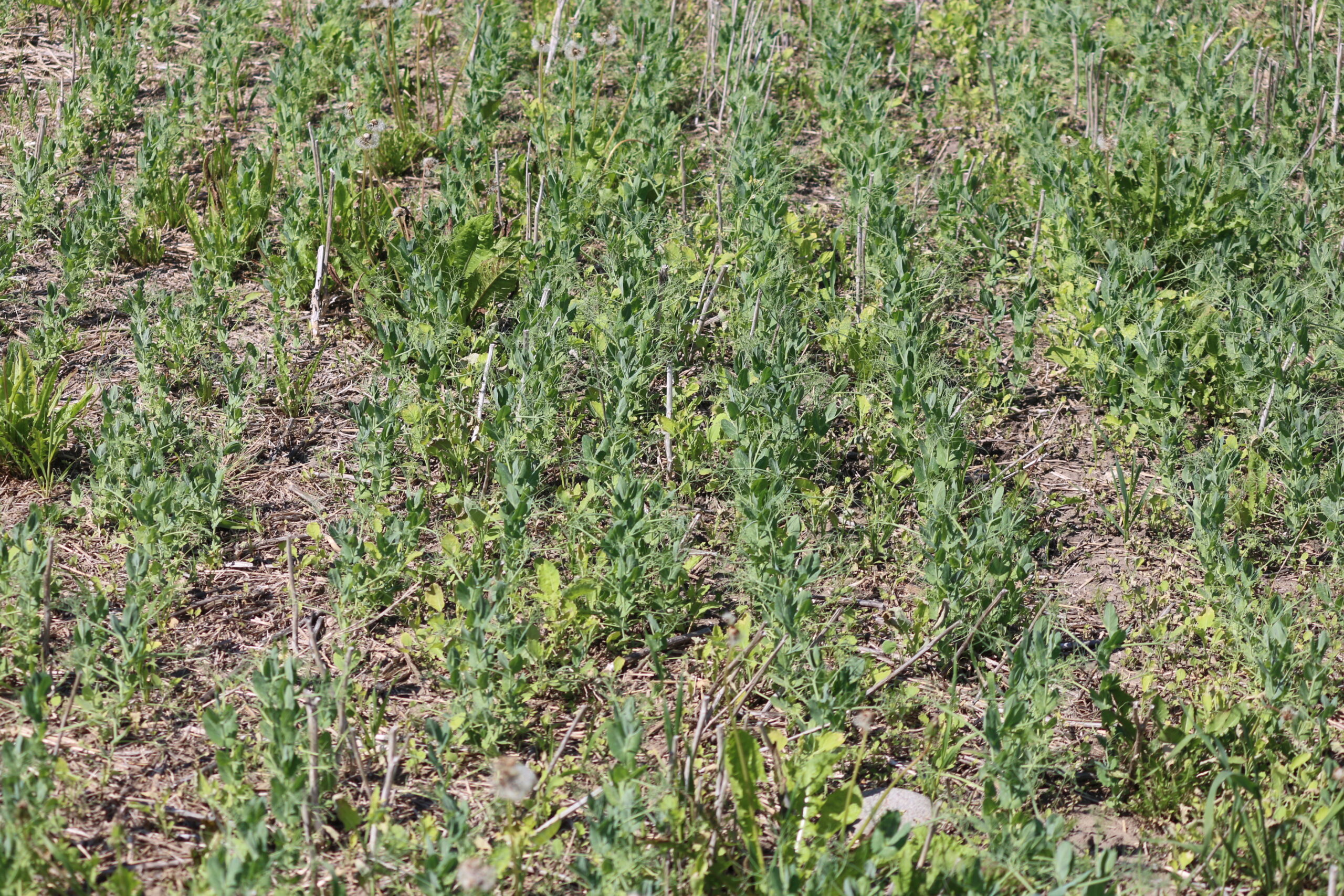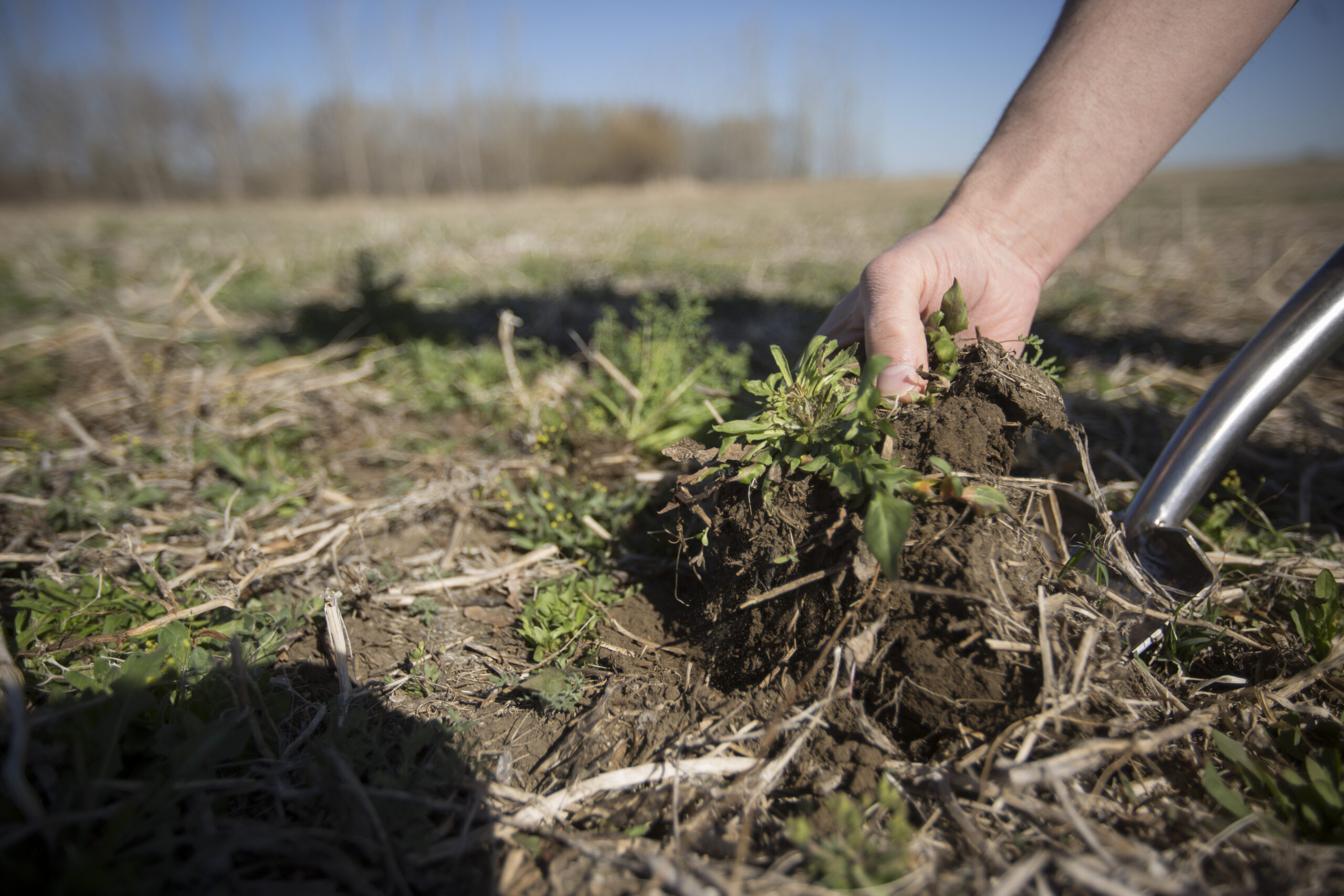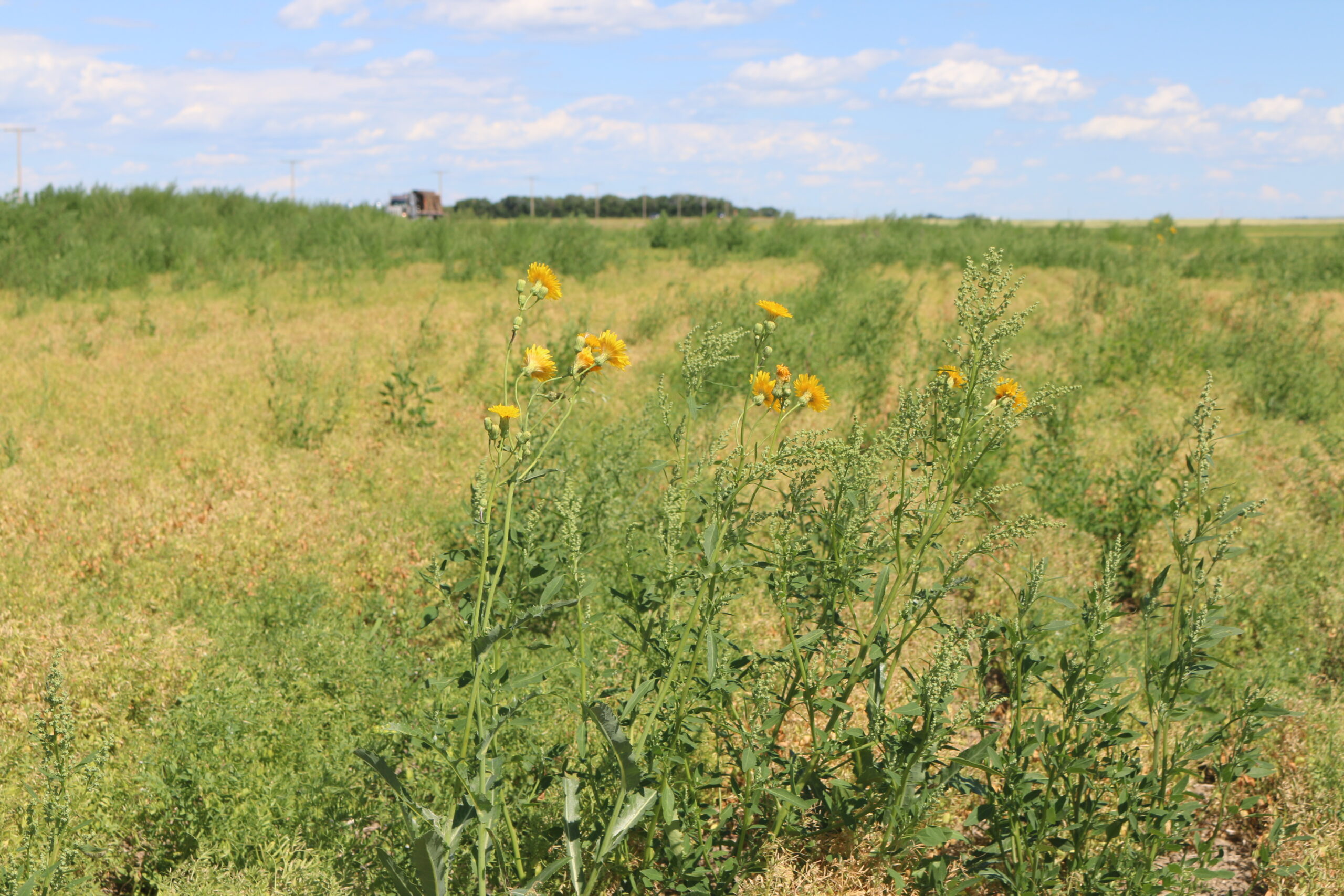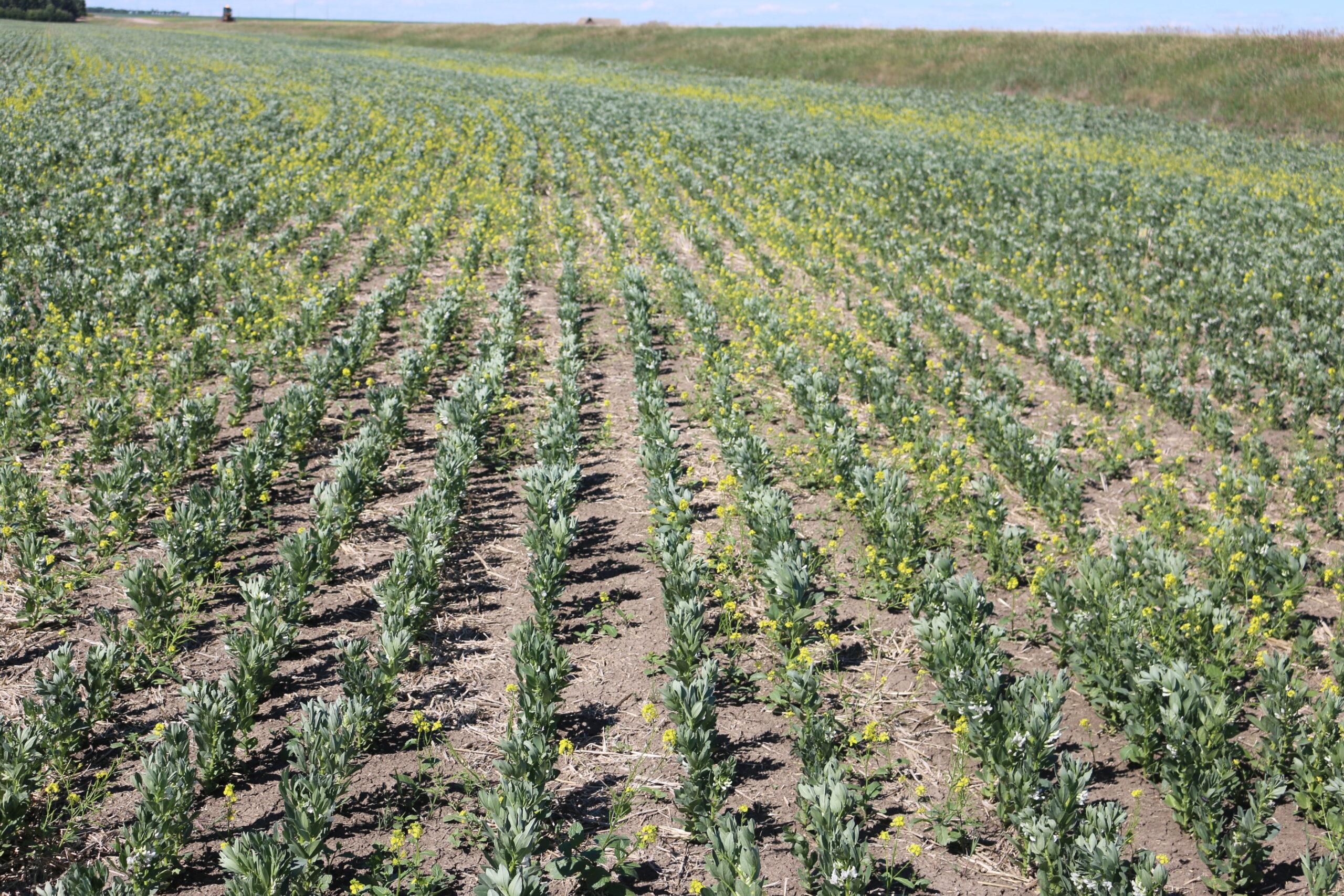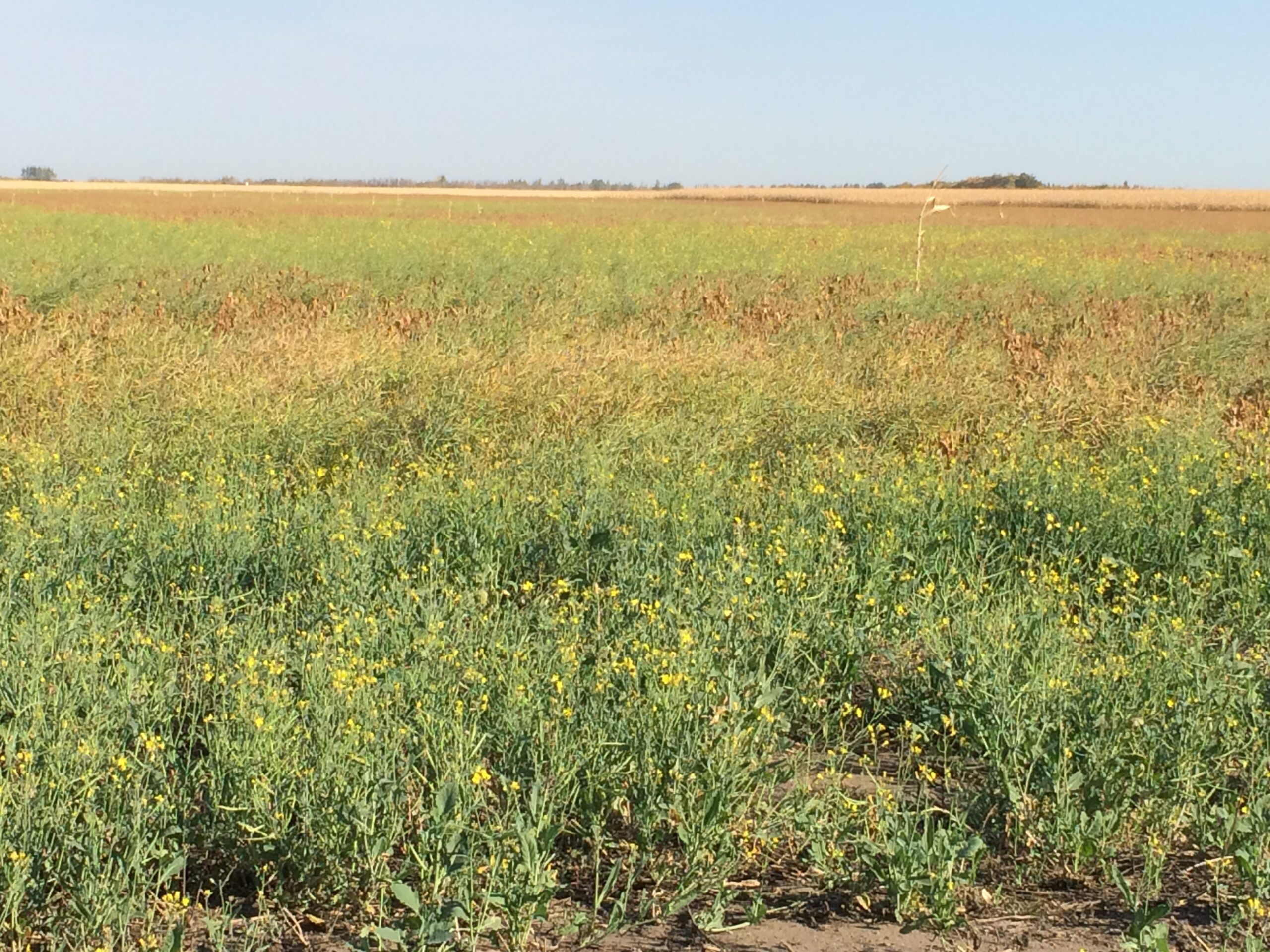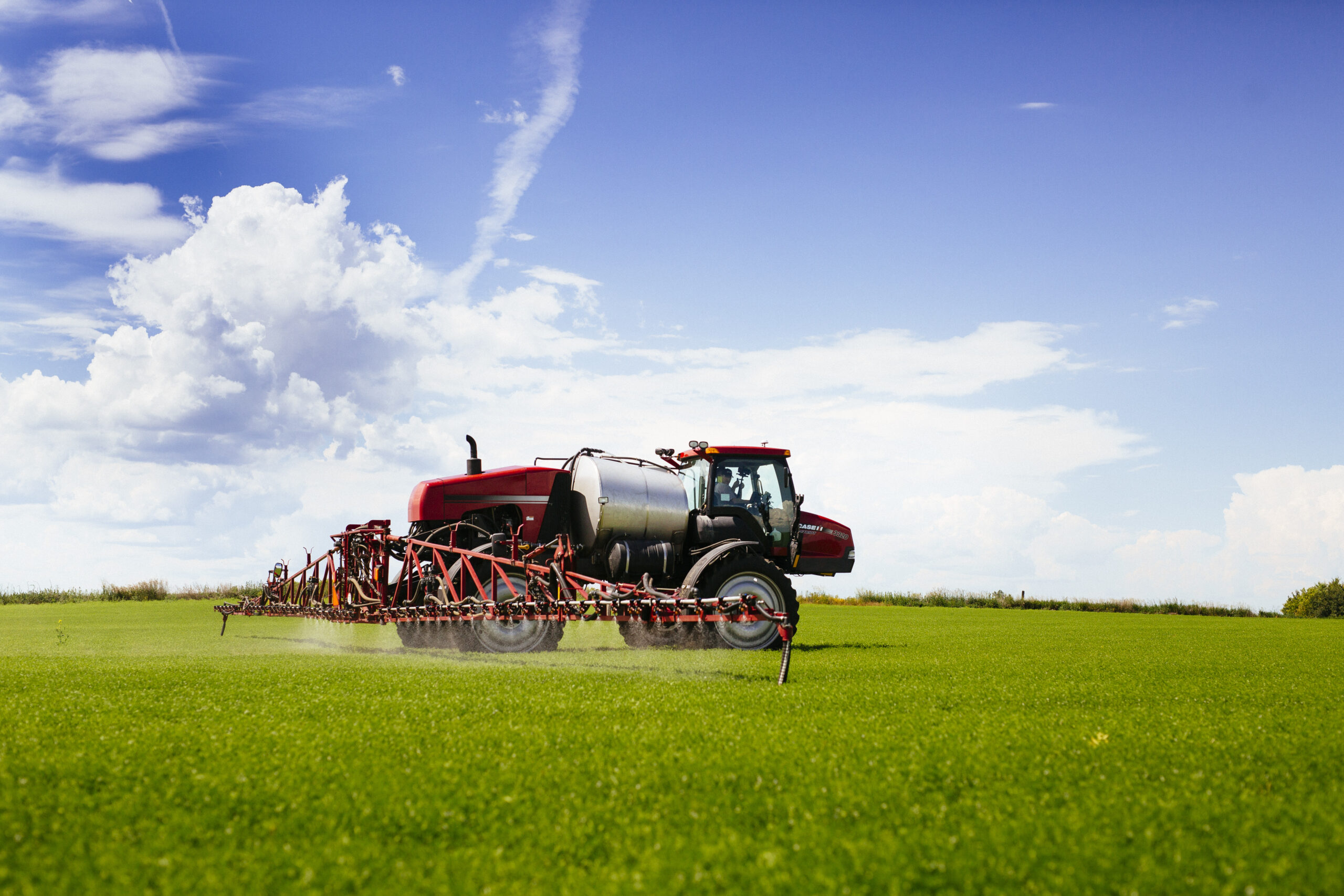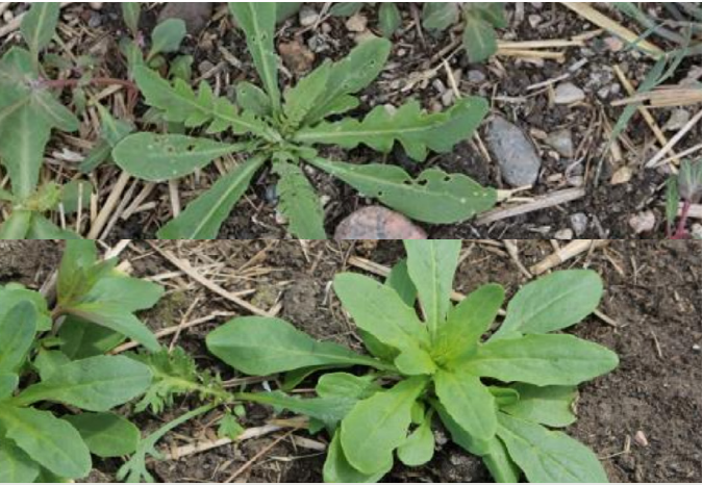Contributing Researchers: Dr. Chris Willenborg, Sid Darras, Eric Johnson, and Dr. Dilshan Benaragama
Pesticides used in these research trials may or may not be registered on the crops they were trialled on. Contact the product manufacturer or consult the product label for registered uses.
Introduction
Limited herbicide options coupled with the growing problem of herbicide-resistant weeds pose significant challenges for weed control in field peas. To address these challenges, Saskatchewan Pulse Growers (SPG) funded four research projects initiated to identify new ways of managing difficult-to-control weeds in field peas.
Researchers investigated the weed control potential of cultural practices, such as integrating winter cereals into rotation. They looked at how cultivar choice combined with seeding rate and early season herbicide strategy might affect weed competition. They explored the potential of new field pea herbicide actives, and they examined the role of thiamethoxam seed treatments in improving the early season competitiveness of field pea.
Key Findings
- Incorporating winter cereals and cover crops into rotation does not appear to have any effect on reducing weed competition for pea crops.
- Increasing field pea seeding rates to a minimum of 120 seeds/m2 while using both a pre-emergence herbicide with residual activity and choosing a naturally competitive pea cultivar is an effective weed control strategy.
- Choosing a competitive field pea cultivar may contribute more to managing weed competition than treating seed with thiamethoxam to alleviate shade avoidance response in seedlings.
- Field peas show reasonable tolerance to the active ingredient pyridate (Group 6). More research is required, however, to determine if it can become an effective post-emergence herbicide in field peas.
Study 1: Integrating winter cereals and cover crops for weed management in field pea
Herbicide-resistant cleavers and kochia are increasingly difficult to control in all crops, but especially in field pea where herbicide options are limited and dominated by Group 2 chemistry. In field pea crops, it is nearly impossible to control kochia populations resistant to both Group 2 and 9, and cleavers resistant to Group 2, by using in-crop herbicides only.
This rotational study was designed to examine the role winter cereals and cover crops might play in managing these weeds over the course of a five-year rotation (Table 1). The reasoning was that kochia, an early-emerging weed, can be well-managed in the winter cereal rotation and that cleavers (a winter annual) could be managed through a combination of winter cereals and cover crops.
The study was planned to run for five years from 2017 to 2021. Poor winter cereal survival during the first two years of the trial meant the project had to be re-started twice, and only three years of the planned five-year rotation were completed. This study was conducted on the Kernen Research Farm (Sutherland heavy clay) and on the Goodale Research Farm (Bradwell fine sandy loam).
The experiment consisted of a randomized complete block design (RCBD) where each treatment (or five-year rotation) was replicated four times (Table 1). For example, Treatment 1 was a five-year rotation that started with peas, followed the next year with spring rye (without a cover crop), followed by canola, followed by spring wheat (also without a cover crop), then finished with peas again. The cover crop used in this experiment consisted of alfalfa under-seeded between winter and spring cereal crop rows.
In the spring of 2019, all treatments began with peas seeded into clean, chem-fallowed plots. In 2020, each treatment was seeded to fall or spring rye, with or without a cover crop. And in 2021, Clearfield® canola was seeded into all treatments. Since the five-year limit of the program had expired by this time, the last two years of the rotation were not completed and so the trial was ended after Year 3, as shown in Table 1.
Table 1: Treatments for integrating winter cereals and cover crops for weed management in field pea.
| Year 1 | Year 2 | Year 3 | Year 4 | Year 5 | |
|---|---|---|---|---|---|
| Treatment | 2019 | 2020 | 2021 | 2022 | 2023 |
| 1 | Pea | Spring Rye | CF Canola | Spring Wheat | Pea |
| No cover crop | No cover crop | ||||
| 2 | Pea | Fall Rye | CF Canola | Spring Wheat | Pea |
| No cover crop | No cover crop | ||||
| 3 | Pea | Fall Rye | CF Canola | Spring Wheat | Pea |
| Cover crop | No cover crop | ||||
| 4 | Pea | Spring Rye | CF Canola | Winter Wheat | Pea |
| No cover crop | No cover crop | ||||
| 5 | Pea | Spring Rye | CF Canola | Winter Wheat | Pea |
| No cover crop | Cover crop | ||||
| 6 | Pea | Fall Rye | CF Canola | Winter Wheat | Pea |
| No cover crop | No cover crop | ||||
| 7 | Pea | Fall Rye | CF Canola | Winter Wheat | Pea |
| Cover crop | Cover crop |
Conclusions
Statistical analysis of the data collected from two sites across three years of the study revealed that none of the rotational treatments had an effect on weed density, weed biomass or crop yield. It’s difficult to predict whether this conclusion would be different had the full five- year rotation been executed as planned.
Study 2: Does pea cultivar + seeding rate + PRE herbicides = improved weed competition?
Research shows there are differences in the weed competitive ability among field pea cultivars. This study aimed to find out whether combining competitive pea cultivars with high seeding rates and PRE (pre-seed or pre-emergence) herbicide use could reduce weed competition in Saskatchewan pea crops.
The study was conducted over three years, from 2017 to 2019, at the Kernen Research Farm. Treatments included two highly competitive and two less competitive pea cultivars, three seeding rates and two PRE herbicide regimens using either glyphosate or Fierce® (Table 2). To test the effectiveness of the weed management treatments Xceed® canola and tame oats were seeded at each site to mimic in-crop weed pressure.
Table 2: Treatments for pea cultivar x seeding rate x PRE herbicide regimen
| Treatment No. | Cultivar | Seeding Rate (Seeds/m2) | PRE-Herbicide selection |
|---|---|---|---|
| Competetive Cultivars | |||
| 1 | CDC Dakota | 80 | Glyphosate |
| 2 | CDC Dakota | 80 | Fierce® (flumioxazin + pyroxasulfone) |
| 3 | CDC Dakota | 120 | Glyphosate |
| 4 | CDC Dakota | 120 | Fierce® |
| 5 | CDC Dakota | 160 | Glyphosate |
| 6 | CDC Dakota | 160 | Fierce® |
| 7 | CDC Patrick | 80 | Glyphosate |
| 8 | CDC Patrick | 80 | Fierce® |
| 9 | CDC Patrick | 120 | Glyphosate |
| 10 | CDC Patrick | 120 | Fierce® |
| 11 | CDC Patrick | 160 | Glyphosate |
| 12 | CDC Patrick | 160 | Fierce® |
| Less competitive cultivars | |||
| 13 | Stratus | 80 | Glyphosate |
| 14 | Stratus | 80 | Fierce® |
| 15 | Stratus | 120 | Glyphosate |
| 16 | Stratus | 120 | Fierce® |
| 17 | Stratus | 160 | Glyphosate |
| 18 | Stratus | 160 | Fierce® |
| 19 | Reward | 80 | Glyphosate |
| 20 | Reward | 80 | Fierce® |
| 21 | Reward | 120 | Glyphosate |
| 22 | Reward | 120 | Fierce® |
| 23 | Reward | 160 | Glyphosate |
| 24 | Reward | 160 | Fierce® |
Conclusions & Recommendations
Improving crop competition through the combined use of competitive pea cultivars planted at higher seeding rates consistently improved the pea crop’s ability to out-compete weeds.
In terms of PRE herbicide use, the study revealed that pre-emergence applications of Fierce® (flumioxazin + pyroxasulfone), both alone and in combination with higher seeding rates, were better than glyphosate alone at managing weeds. This shows that even when seeding a competitive pea cultivar, using a pre-emergent soil residual herbicide will provide the best possible weed control later in the season.
Researchers concluded that a prudent practice for pea growers going forward is to increase seeding rates to a minimum of 120 seeds/m2, and use a pre-emergence herbicide with residual activity and a competitive cultivar. Together, these three practices will help improve field pea yield overall and reduce losses to weed competition.
Study 3: Can thiamethoxam seed treatment improve the competitive ability of field pea?
Previous research conducted at the University of Saskatchewan suggests that pea responds negatively to the presence of neighbouring plants and that they do not discriminate between friend (other pea plants) or foe (weeds). Like other plants, peas often react to the presence of these neighbours with a shade avoidance response, which can result in changes to plant morphology, such as increased apical dominance, reduced branching, and reduced root-to-shoot ratio.
Recent research from the University of Guelph suggests that corn seedlings grown from seed treated with thiamethoxam (Cruiser®) do not exhibit the same shade avoidance behaviour when in the presence of neighbours. The question is: are other crops impacted by thiamethoxam in this way?
This experiment was designed to evaluate whether treating field pea seeds with thiamethoxam improves the crop’s competitive ability in the field. Using a randomized complete block design, researchers tested various combinations of two pea cultivars (one competitive and one less so) and two seed treatments (Apron Maxx® and Cruiser Maxx®) to see what effect they had on weed competition (Table 3). Note that Apron Maxx and Cruiser Maxx have identical fungicide packages and that the only difference between them is that Cruiser Maxx contains thiamethoxam.
The trial was conducted in Scott, Saskatchewan (Scott loam soils) from 2017 to 2019, and at the Kernen Research Farm in 2018, 2019, and 2021. Xceed canola was seeded to simulate wild mustard weed population pressure, otherwise, all weeds were removed from the plots. Plots were also hand-thinned to ensure crop and weed densities remained constant.
Table 3. Treatments to evaluate the effect of seed treatments on the early-season competitive ability of field pea.
| Treatment No. | Cultivar | Seeding Treatment | Weed Competition |
|---|---|---|---|
| Competetive Cultivars | |||
| 1 | CDC Dakota | None | None |
| 2 | CDC Dakota | None | Present |
| 3 | CDC Dakota | Apron Maxx® | None |
| 4 | CDC Dakota | Apron Maxx® | Present |
| 5 | CDC Dakota | Cruiser Maxx® | None |
| 6 | CDC Dakota | Cruiser Maxx® | Present |
| Less competitive cultivars | |||
| 7 | Stratus | None | Non |
| 8 | Stratus | None | Present |
| 9 | Stratus | Apron Maxx® | None |
| 10 | Stratus | Apron Maxx® | Present |
| 11 | Stratus | Cruiser Maxx® | None |
| 12 | Stratus | Cruiser Maxx® | Present |
Conclusions & Recommendations
This study found thiamethoxam seed treatment does not deliver consistent benefits in terms of improving field pea competitiveness and mitigating yield loss from weed competition. The inconsistency in pea response may be due to environmental conditions over the length of the project. It is also entirely possible that field pea simply doesn’t respond to thiamethoxam the way corn and soybeans do.
In conclusion, growing more competitive pea cultivars provides greater weed competition rather than treating pea seed with thiamethoxam-based seed treatment. Growers are encouraged to consider cultivar choice as an integral component of their weed management system.
Study 4: Pyridate tolerance in field pea
Group 2 herbicides dominate current product options available to field pea producers in Saskatchewan. With the continued increase in herbicide-resistant weed species, expanding the list of useful active ingredients for pulse crops is a pressing agronomic issue. Researchers identified pyridate, a Group 6 broadleaf herbicide that has been used in horticultural crops for many years, as a possible new herbicide in field pea in Western Canada.
In Canada, pyridate is sold as Tough® 600EC and used as pre-seed or pre-emergence herbicide in several crops, including dry peas, to control key weeds like wild mustard, lamb’s quarters, kochia and redroot pigweed.
To analyze the suitability of pyridate as an in-crop or post-emergence herbicide application in field pea, a field study was conducted at the Kernen Research Farm in 2019 and 2020. Treatments included pyridate applied at a 1x rate and 2x rate, an industry-standard herbicide, and an untreated check applied at the 2- to 3-node stage:
- Pyridate at the 1x rate (900 g ai/ha)
- Pyridate at the 2x rate (1,800 g ai/ha)
- Basagran® (bentazon), the industry standard Group 6 herbicide for pulses
- Hand-weeded untreated check
In 2019, the crop injury observed varied from 20 to 40%, but the plants recovered with no yield difference among all herbicide treatments. In 2020, pyridate at the 1x rate produced no observable injury, while 2x rate resulted in nearly 20% crop damage still present 27 days after application (DAA) (Figure 1). The crop recovered, however, and no significant differences in pea yield was observed across all herbicide treatments (Figure 2).


Conclusions
Field pea tolerates low rates of pyridate well, and while relatively significant crop injury occurred when high rates were used, the crop seemed to recover well with no reduction in yield. More research is needed to determine if pyridate could become an effective post- emergence herbicide option for pea growers. Testing has reverted to Belchim Crop Protection Canada, the company that owns this active.
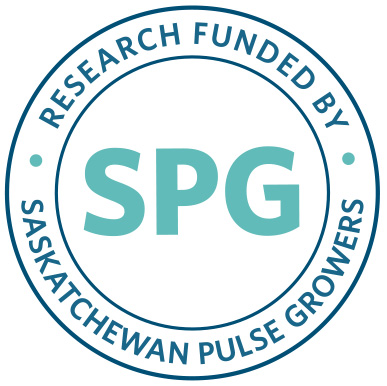
Enhancing weeds science in pulse crops: Towards a robust strategy for long-term weed management
Dr. Christian Willenborg University of Saskatchewan – Dept. of Plant Sciences Objective
